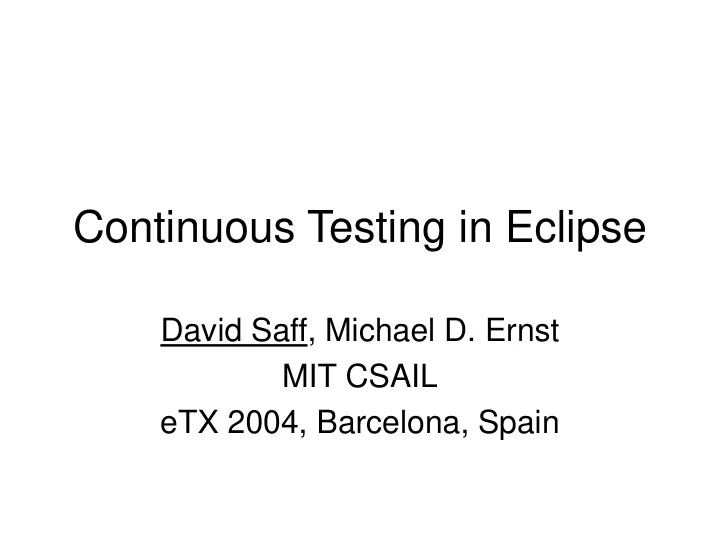

Continuous Testing in Eclipse David Saff, Michael D. Ernst MIT CSAIL eTX 2004, Barcelona, Spain
Continuous testing: inspired by continuous compilation • Continuous compilation, as in Eclipse, notifies the developer quickly when a syntactic error is introduced: • Continuous testing notifies the developer quickly when a semantic error is introduced:
Outline • Continuous testing: defined and motivated • Eclipse plug-in: – Design principles – User interface design: demo – Software design • Next steps
Outline • Continuous testing: defined and motivated • Eclipse plug-in: – Design principles – User interface design: demo – Software design • Next steps
Continuous testing • Continuous testing developer uses excess cycles changes on a developer's code workstation to continuously run IDE IDE listens notifies regression tests in for about the background as changes errors the developer edits code. daemon runs tests
Goals of continuous testing Continuous testing: • No longer forces the developer to decide whether to test and what tests to run. • Prevents long-standing regression errors.* • Makes developer confident, not annoyed. * Saff, Ernst, ISSRE 2003: Reducing wasted development time via continuous testing
Continuous testing made students more productive Treatment N Completed assignment No tool 11 27% Continuous compilation 10 50% Continuous testing & 18 78% continuous compilation p < .03 * Saff, Ernst, ISSTA 2004: An experimental evaluation of continuous testing during development
Students appreciated continuous testing I would use continuous Yes testing… …for the rest of the course 94% …for my own programming 80% I would recommend the tool 90% to others
Outline • Continuous testing: defined and motivated • Eclipse plug-in: – Design principles – User interface design: demo – Software design • Next steps
Design principles, 1 of 2 • Reuse – Whenever possible, plug in and reuse • Future reuse – When reuse is impossible, copy and paste to show where Eclipse could be more flexible
Design principles, 2 of 2 • Consistent experience – Don’t change expected behavior – Build on current developer metaphors • Minimal distraction – Don’t swamp benefits by sapping attention • Testability – Add testing- specific API’s when necessary
Outline • Continuous testing: defined and motivated • Eclipse plug-in: – Design principles – User interface design: demo – Software design • Next steps
Outline • Continuous testing: defined and motivated • Eclipse plug-in: – Design principles – User interface design: demo – Software design • Next steps
Eclipse auto-building: Static structure Project Builder * * * Java RMI builder builder Source file
Eclipse auto-building: Dynamic behavior runs Project Builder * * Auto-build Thread creates * Java RMI starts builder builder Source file * Marker * Problems changes view updates Build Delta Manager notifies
Eclipse launching: Static structure Launch Launch config config type has classes * Launch Application JUnit project Runtime workbench
Eclipse launching: Dynamic behavior (JUnit) Launch Launch Remote config config type test runner Socket Launch JUnit project Classpath updates Test Test Launch runner runner project client GUI Launched JVM Eclipse JVM
Continuous Testing Static structure when changes Launch Launch config config type Project has classes * Builder Testing Launch Continuous * metadata project testing Source file Java CT builder builder
Places we Continuous Testing had Dynamic behavior difficulty when changes Testing multiple Testing multiple asynchronous asynchronous Launch Launch CT Project config units is hard units is hard config test type runner Socket Classpath * JUnit runtime Testing Testing Launch Launch Source file meta- meta- CT structure copied project project data data Launched JVM CT CT * Problem icon runner runner Problems view selection hacks updates client GUI updates Marker internal classes creates Eclipse JVM
Suggestions for Eclipse • JUnit integration: – Display results from multiple simultaneous test runs – Allow plug-ins to contribute prioritization • Problems view: – More flexibility in icons • Tools for testing asynchrony – It’s hard to create deterministic unit tests
Outline • Continuous testing: defined and motivated • Eclipse plug-in: – Design principles – User interface design: demo – Software design • Next steps
Next steps: split into individual plug-ins Current plug-in Create Associate Run tests markers Prioritize launches when based on tests with project test projects changes failures
Next steps: feature enhancements • Extend to Plug-in Development Environment • Prioritize based on which methods, classes, etc. changed • Use hot-swapping JVM to reduce start-up time • Increase resolution: associate suite with package? class? method?
Next steps: test factoring • User-supplied test: • Factored tests: Expected Result Expected Result Method Call Method Call Expected Result Mock Object Method Call * Saff, Ernst, PASTE 2004: Automatic mock object creation for test factoring
Further reading • Model of developer behavior – Saff, Ernst, ISSRE 2003: Reducing wasted development time via continuous testing • Controlled student experiment – Saff, Ernst, ISSTA 2004: An experimental evaluation of continuous testing during development • Test factoring – Saff, Ernst, PASTE 2004: Automatic mock object creation for test factoring
Conclusion • Plug-in is publicly available at http://pag.csail.mit.edu/~saff/continuoustesting.html • Many are using and enjoying continuous testing: give it a try! • Eclipse was an excellent platform for meeting our design goals. • Research and implementation continues
Recommend
More recommend